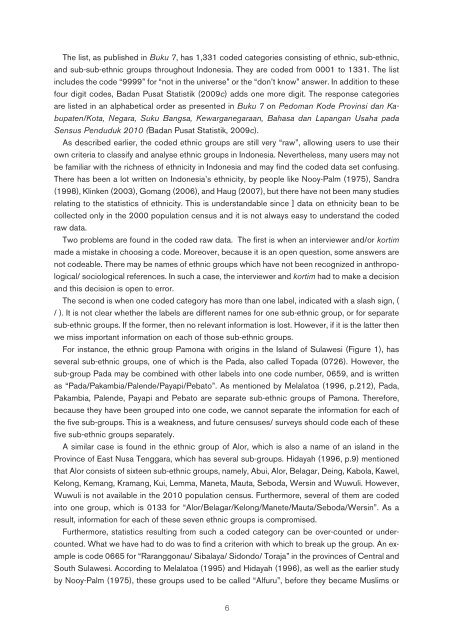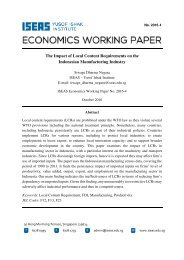1eM4IJR
1eM4IJR
1eM4IJR
You also want an ePaper? Increase the reach of your titles
YUMPU automatically turns print PDFs into web optimized ePapers that Google loves.
The list, as published in Buku 7, has 1,331 coded categories consisting of ethnic, sub-ethnic,<br />
and sub-sub-ethnic groups throughout Indonesia. They are coded from 0001 to 1331. The list<br />
includes the code “9999” for “not in the universe” or the “don’t know” answer. In addition to these<br />
four digit codes, Badan Pusat Statistik (2009c) adds one more digit. The response categories<br />
are listed in an alphabetical order as presented in Buku 7 on Pedoman Kode Provinsi dan Kabupaten/Kota,<br />
Negara, Suku Bangsa, Kewarganegaraan, Bahasa dan Lapangan Usaha pada<br />
Sensus Penduduk 2010 (Badan Pusat Statistik, 2009c).<br />
As described earlier, the coded ethnic groups are still very “raw”, allowing users to use their<br />
own criteria to classify and analyse ethnic groups in Indonesia. Nevertheless, many users may not<br />
be familiar with the richness of ethnicity in Indonesia and may find the coded data set confusing.<br />
There has been a lot written on Indonesia’s ethnicity, by people like Nooy-Palm (1975), Sandra<br />
(1998), Klinken (2003), Gomang (2006), and Haug (2007), but there have not been many studies<br />
relating to the statistics of ethnicity. This is understandable since ] data on ethnicity bean to be<br />
collected only in the 2000 population census and it is not always easy to understand the coded<br />
raw data.<br />
Two problems are found in the coded raw data. The first is when an interviewer and/or kortim<br />
made a mistake in choosing a code. Moreover, because it is an open question, some answers are<br />
not codeable. There may be names of ethnic groups which have not been recognized in anthropological/<br />
sociological references. In such a case, the interviewer and kortim had to make a decision<br />
and this decision is open to error.<br />
The second is when one coded category has more than one label, indicated with a slash sign, (<br />
/ ). It is not clear whether the labels are different names for one sub-ethnic group, or for separate<br />
sub-ethnic groups. If the former, then no relevant information is lost. However, if it is the latter then<br />
we miss important information on each of those sub-ethnic groups.<br />
For instance, the ethnic group Pamona with origins in the Island of Sulawesi (Figure 1), has<br />
several sub-ethnic groups, one of which is the Pada, also called Topada (0726). However, the<br />
sub-group Pada may be combined with other labels into one code number, 0659, and is written<br />
as “Pada/Pakambia/Palende/Payapi/Pebato”. As mentioned by Melalatoa (1996, p.212), Pada,<br />
Pakambia, Palende, Payapi and Pebato are separate sub-ethnic groups of Pamona. Therefore,<br />
because they have been grouped into one code, we cannot separate the information for each of<br />
the five sub-groups. This is a weakness, and future censuses/ surveys should code each of these<br />
five sub-ethnic groups separately.<br />
A similar case is found in the ethnic group of Alor, which is also a name of an island in the<br />
Province of East Nusa Tenggara, which has several sub-groups. Hidayah (1996, p.9) mentioned<br />
that Alor consists of sixteen sub-ethnic groups, namely, Abui, Alor, Belagar, Deing, Kabola, Kawel,<br />
Kelong, Kemang, Kramang, Kui, Lemma, Maneta, Mauta, Seboda, Wersin and Wuwuli. However,<br />
Wuwuli is not available in the 2010 population census. Furthermore, several of them are coded<br />
into one group, which is 0133 for “Alor/Belagar/Kelong/Manete/Mauta/Seboda/Wersin”. As a<br />
result, information for each of these seven ethnic groups is compromised.<br />
Furthermore, statistics resulting from such a coded category can be over-counted or undercounted.<br />
What we have had to do was to find a criterion with which to break up the group. An example<br />
is code 0665 for “Raranggonau/ Sibalaya/ Sidondo/ Toraja” in the provinces of Central and<br />
South Sulawesi. According to Melalatoa (1995) and Hidayah (1996), as well as the earlier study<br />
by Nooy-Palm (1975), these groups used to be called “Alfuru”, before they became Muslims or<br />
6



